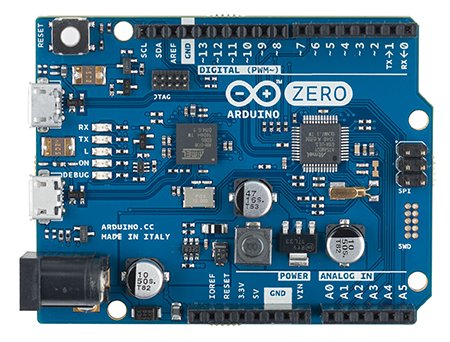Arduino Zero Overview
The Arduino Zero is a simple and powerful 32-bit extension of the platform established by Arduino UNO. The Zero board aims to provide creative individuals with the potential to realize truly innovative ideas for smart IoT devices, wearable technology, high-tech automation, crazy robotics, and projects not yet imagined. The board is powered by Atmel’s SAMD21 MCU, which features a 32-bit ARM Cortex® M0+ core.
The Zero board expands the Arduino family by providing increased performance to fuel the creativity of the maker community. The flexible feature set enables endless project opportunities for devices and acts as a great educational tool for learning about 32-bit application development. One of its most important feature is Atmel’s Embedded Debugger (EDBG), which provides a full debug interface without the need for additional hardware, significantly increasing the ease-of-use for software debugging. EDBG also supports a virtual COM port that can be used for device programming and traditional Arduino boot loader functionality.
Arduino Zero Pinout & Image


Arduino and Atmel unveil the Arduino Zero, a simple and powerful 32-bit extension of the platform established by Arduino UNO. It aims to provide creative individuals with the potential to realize truly innovative ideas especially for smart IoT devices, wearable technology, high-tech automation, crazy robotics, and projects not yet imagined.
The board is powered by Atmel’s SAMD21 MCU, which features a 32-bit ARM Cortex® M0+ core and one of its most important feature is Atmel’s Embedded Debugger (EDBG), which provides a full debug interface without the need for additional hardware, significantly increasing the ease-of-use for software debugging. EDBG also supports a virtual COM port that can be used for device programming and traditional Arduino boot loader functionality.
Massimo Banzi, Arduino co-founder and CEO said:
“The flexible feature set enables endless project opportunities for devices and acts as a great educational tool for learning about 32-bit application development.”
Summary
| Microcontroller | ATSAMD21G18, 48pins LQFP |
| Operating Voltage | 3.3V |
| Digital I/O Pins | 14, with 12 PWM and UART |
| Analog Input Pins | 6, 12-bit ADC channels |
| Analog Output Pins | 1, 10-bit DAC |
| DC Current per I/O Pin | 7 mA |
| Flash Memory | 256 KB |
| SRAM | 32 KB |
| EEPROM | up to 16KB by emulation |
| Clock Speed | 48 MHz |
For further information visit: Arduino Zero and MEET ARDUINO ZERO – THE NEW BOARD JOINTLY DEVELOPED BY ARDUINO AND ATMEL
